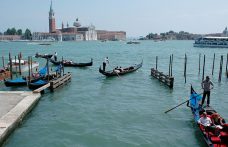
What cisgenesis is and why it can save us from climate change

There is a theory of desertification on the Apulian, Sicilian and Sardinian coasts in thirty years’ time, caused by climate change. Forecasts have even been “raised to a 3°C increase in average seasonal temperatures.” In the now notorious 2017, “up to -65% rainfall was recorded in Tuscany, Umbria and Sardinia.” It is no longer a chance event in the climate cycle of our latitudes, it is unfortunately becoming the rule. With these words, Professor Attilio Scienza invoked an alliance to introduce cisgenesis into Italian viticulture. “We must make quick decisions, we can’t wait for the future.”
How can we face climate change?
On Sunday 22nd October, Scienza connected via internet with the Hilton Giardini Naxos, where the fifth edition of Taormina Gourmet was about to come to an end. Luigi Moio, professor at Naples University, and Riccardo Cotarella, president of Assoenologi, also took part in the meeting “Wine and climate change”. Professor Scienza highlighted the most crucial aspects of what he defined as the “tyranny of the climate”. Then he put forward possible solutions on three levels: research in the medium-term period and intervention on viticulture and winemaking as a temporary solution. All these solutions are costly and too ineffective or too indecisive over time.
Cisgenesis is a concrete solution
“We must act on current varieties, without modifying their quality, and to do this we must accept the decision to intervene on DNA. The future lies in genetics.” The professor is referring to cisgenesis, which involves inserting one or more genes recovered from plants that belong to the same genus or species, while transgenesis entails the use of genes from genetically unlike individuals, for example bacteria or fungi. This is the significant difference between GMOs and cisgenic individuals. The aim is to obtain later-ripening varieties with more control over acidity, but without changing the distinctive characteristics of the original wine. The idea is also to work on traditional grape varieties, to make them tolerant to cryptogamic diseases and create rootstocks that use water more efficiently.
Innovative rootstocks to save water
New rootstocks created in recent years by Milan University enable a water saving of up to 40%. It is also possible to get interesting results with traditional crosses, but the time span is longer, taking at least 15-20 years to achieve tangible results. “We don’t have any more time,” Scienza added, quoting Saint Augustine’s maxim on the past, present and future, which collapses in moments like this because of the need to make prompt decisions. For these projects to reach a conclusion, people need to accept genetics, which is viewed very suspiciously by the general public today. An alliance needs to be made between producers, universities and consumers in order to include cisgenesis as one of the procedures for genetic improvement. Today, it is still equated with transgenesis on a European level, therefore it is banned.
See also ...


The battle continues with the new Chianti Gran Selezione
On 11th November, the Chianti Wine Consortium announced Read more


Changes at the top in Genagricola and Santa Margherita
Big news in Genagricola and Santa Margherita Gruppo Read more


Pinot Grigio delle Venezie: the first national conference
The curtain will rise on the new appellation Read more
